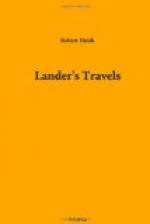The country round Koolfu is a level plain, well cultivated, and studded with little walled towns and villages along the banks of the May Yarrow, and of a little river running into it from the north. Between the walled towns of Bullabulla and Rajadawa, the route passed through plantations of grain, indigo, and cotton; the soil clay mixed with sand, with here and there large blocks of sandstone, containing nodules of iron and veins of iron-stone.
At five days from Koolfu, the route entered at the town of Wazo, or Wazawo, the district of Koteng Koro, formerly included in Kashna; and for another five days’ journey through a rich and beautiful valley, and over woody hills, the travellers reached Womba, a large walled town, where the caravans both from the east and the west generally halt a day or two, and where, as at Wazo, a toll is levied on merchandise. The town stands on a rising ground, at the eastern head of a valley watered by a small stream, having three bare rocky hills of granite to the north, east, and south. The inhabitants may amount to between ten and twelve thousand souls. The travellers were here objects of much kindness; the principal people of the place sent presents, and the lower ranks sought to obtain a sight of them by mounting the trees which overlooked their residence. The Koran does not seem to have much embarrassed these people; their only mode of studying it was to have the characters written with a black substance on a piece of board, then to wash them off and drink the water; and when asked what spiritual benefit could be derived from the mere swallowing of dirty water, they indignantly retorted, “What! do you call the name of God dirty water?” This mode of imbibing sacred truth is indeed extensively pursued throughout the interior of the African continent.
On the second day from Womba, the travellers passed through another large and populous town, called Akinjie, where also kafilas pay toll; beyond which, the route lay for two days over a very hilly country, for the most part covered with wood, and but little cultivated, till they approached Guari.
This town, the capital of a district of the same name, formerly included in Kashna, is built partly on a hill, and partly in a narrow valley, through which runs a muddy stream, that is dry in summer; this stream, the source of which is only a day’s journey distant, divides in one part the states of Kotong Kora and Guari, and falls into the Kodonia in Nyffee. The district of Guari was conquered by the Fellatas, in a short time after their rising, together with the rest of Houssa. On the death of old Bello, the father of the then reigning sovereign, these districts, with the greater part of Kashna, joined in the towia, or confederacy, against the Fellatas. The chief of Zamfra was the first to shake the spear of rebellion, and he was soon joined by the natives of Goober, and the northern parts of Kashna, by Guari and Kotong Kora, and at length by the states of Youri, Cubbi, Doura, and the southern part of Zeg Zeg. The strength of Youri is said to lie in the bravery of its inhabitants, and the number of horse they can bring into the field, amounting to a thousand. Clapperton was, however, disposed to place their real strength in the hilly and woody nature of their country.




